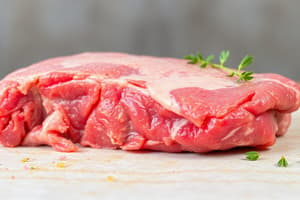Podcast
Questions and Answers
What is a characteristic of meat that makes it highly perishable?
What is a characteristic of meat that makes it highly perishable?
- Its protein-rich composition
- Its high water content
- Its low nutritional value
- Its susceptibility to microbial growth (correct)
What type of microorganisms can grow on meat and meat products?
What type of microorganisms can grow on meat and meat products?
- Only yeasts and molds
- Only viruses
- A variety of microflora, including bacteria, yeasts, and molds (correct)
- Only bacteria
What is a natural process that can cause meat spoilage?
What is a natural process that can cause meat spoilage?
- Microbial contamination
- Lipid oxidation (correct)
- Autolytic enzymatic reaction
- All of the above
What is a factor that contributes to microbial contamination of meat?
What is a factor that contributes to microbial contamination of meat?
What is a method of controlling microbial growth in meat preservation?
What is a method of controlling microbial growth in meat preservation?
What is the purpose of using chemicals in meat preservation?
What is the purpose of using chemicals in meat preservation?
What is a consequence of meat spoilage?
What is a consequence of meat spoilage?
What is a purpose of meat preservation methods?
What is a purpose of meat preservation methods?
Flashcards are hidden until you start studying
Study Notes
Meat Food Spoilage
- Meat is a nutritious, protein-rich food that is highly perishable and has a short shelf-life unless preservation methods are used.
- Meat and its products provide excellent growth media for a variety of microflora (bacteria, yeasts, and molds), some of which are pathogens.
- Meat spoilage can be caused by natural processes, such as lipid oxidation or autolytic enzymatic reactions that occur in the muscle after slaughtering.
- Factors responsible for microbial contamination of meat include:
- Bacterial microorganisms from animals
- Knives, hands, and clothing of workers
- Pre-slaughter handling of livestock and post-slaughter handling of meat
- Handling during slaughtering, evisceration, and processing
- Temperature controls during slaughtering, processing, and distribution
- Type of packaging used
- Handling and storage
Meat Preservation Methods
- Meat preservation methods include:
- Controlling temperature by chilling and freezing
- Controlling water activity with sodium chloride and sugars
- Using different chemicals, such as:
- Chlorides
- Nitrites
- Sulfides
- Organic acids
- Phenolic antioxidants
- Phosphates
- These methods help to:
- Control growth of microorganisms
- Prevent oxidative spoilage
- Control autolytic enzymatic spoilage
Studying That Suits You
Use AI to generate personalized quizzes and flashcards to suit your learning preferences.




